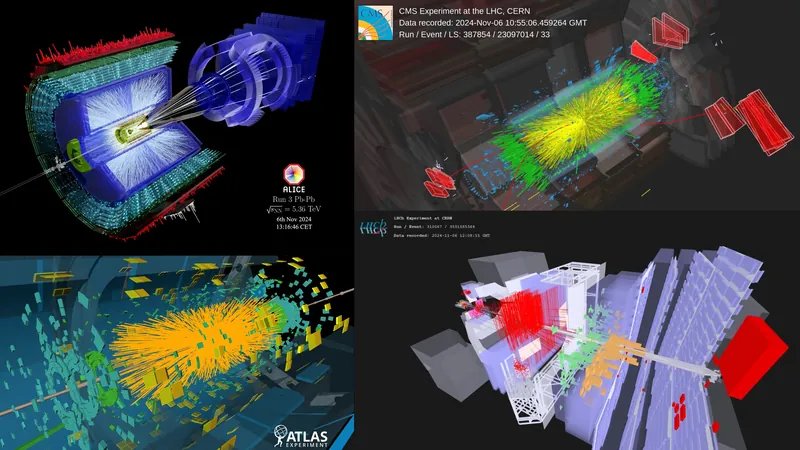
The Exciting Launch of the Heavy-Ion Run at the LHC: A Glimpse into Our Cosmic Origins
2024-11-11
Author: Wei Ling
Introduction
The Large Hadron Collider (LHC) is often considered a colossal cosmic oven, capable of creating some of the universe's most exotic and elusive states of matter. Among these is the quark–gluon plasma, a primordial substance believed to have existed in the microseconds following the Big Bang. While the LHC primarily focuses on proton collisions, it dedicates a special segment of time each year to collide heavy ions, such as lead nuclei, vital for recreating this early universe soup.
Launch of the Heavy-Ion Run
On November 6th at precisely 11:13 AM, the LHC kicked off its highly anticipated heavy-ion run. This year's collisions involve lead ions composed of 208 nucleons—82 protons and 126 neutrons—fired at an impressive energy of 5.36 TeV per nucleon pair. This run is set to unfold over nearly three weeks, generating a treasure trove of data that will keep physicists busy for years as they seek to unravel the secrets of the cosmos' infancy.
Boosting Luminosity
CERN's accelerator physicists are ramping up efforts this year, aiming to boost the machine's luminosity with a goal of at least 30% more collisions daily than in 2023. Roderik Bruce, the LHC coordinator for the heavy-ion program, proudly explained that new advanced techniques—like crystal collimation and a shorter bunch spacing injection scheme—have been implemented to enhance the density of lead ions in a beam.
Upgrades to the ALICE Detector
The ALICE (A Large Ion Collider Experiment) detector at CERN is specifically dedicated to heavy-ion physics and has undergone significant upgrades during the last long shutdown. These enhancements will enable it to collect and store a much larger number of collision events than previously possible. ALICE spokesperson Marco van Leeuwen expressed enthusiasm for the upcoming data set, which is expected to allow scientists to directly measure the temperature of the quark–gluon plasma and study its various properties with unmatched precision.
Other Experiments at the LHC
In addition to ALICE, other experiments at the LHC are ready to capitalize on this unique heavy-ion run. The CMS (Compact Muon Solenoid) detector has accelerated its data collection capacity from 20 gigabytes to a staggering 30 gigabytes per second, ensuring every collision event can be analyzed without the need for initial data filtering. Meanwhile, the ATLAS detector has adapted to new data acquisition technologies, sharpening its focus on particle jets and leptons while improving its capabilities for ultra-peripheral collisions.
Enhancements to the LHCb Detector
Additionally, the LHCb (Large Hadron Collider beauty) detector will experience a 70% boost in instantaneous luminosity compared to the previous year. This enhancement will allow LHCb to gather robust data on lead–lead collisions, as well as explore rare phenomena like the production of beauty hadrons. A notable upgrade this year involves the ability to inject noble gases such as neon and argon into its SMOG2 system, facilitating the collection of lead–neon and lead–argon data along with traditional lead–lead collision data.
Importance of Quark–Gluon Plasma Research
The study of quark–gluon plasma offers profound insight into how the fundamental constituents of matter emerged in the universe a mere hundredth of a billionth of a second after the Big Bang. The ongoing heavy-ion run presents a rare opportunity for scientists at the LHC to explore matter under extreme conditions, illuminating the history of our universe and the forces that shaped it.
Conclusion
Stay tuned as updates from the heavy-ion run promise to unveil groundbreaking discoveries about our cosmic origins!






 Brasil (PT)
Brasil (PT)
 Canada (EN)
Canada (EN)
 Chile (ES)
Chile (ES)
 España (ES)
España (ES)
 France (FR)
France (FR)
 Hong Kong (EN)
Hong Kong (EN)
 Italia (IT)
Italia (IT)
 日本 (JA)
日本 (JA)
 Magyarország (HU)
Magyarország (HU)
 Norge (NO)
Norge (NO)
 Polska (PL)
Polska (PL)
 Schweiz (DE)
Schweiz (DE)
 Singapore (EN)
Singapore (EN)
 Sverige (SV)
Sverige (SV)
 Suomi (FI)
Suomi (FI)
 Türkiye (TR)
Türkiye (TR)